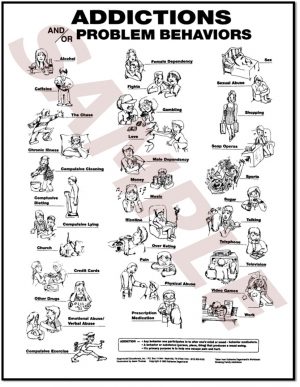 We are all addicted. How dare you say that? Well, if you live in the 21st Century, you are addicted. How come? Because addiction is simply pleasure seeking behavior. The hunt for more endorphins.
We are all addicted. How dare you say that? Well, if you live in the 21st Century, you are addicted. How come? Because addiction is simply pleasure seeking behavior. The hunt for more endorphins.
There are two kinds of pleasure:
- Seeking for excitement or other dopamine releasing activity or substance
- seeking for the cessation of some discomfort or pain. Ask a person who is in pain and ask what they want. They won’t say: I want a shot of whiskey. They will say: I want this pain to stop. That is also pleasure seeking behavior, just like:Escape from depression.
Escape from the noise of the world.
Escape from your troubles.
Escape from your pressing duties.
Escape from your debts, worries, pain, anxiety, phobias, fears, guilt, etc. is all pleasure seeking activity.
Which makes us all addicted. To different things, to different degrees, but yet…
Escaping pain: whether it is the pain of failure, the pain of aimlessness, the “I never amounted to anything” pain, it hurts. Escape is not the best route though. The best way to really escape your pain is to deal with your pain, to face it. But we have a problem, and I am pissed.
Listen to a 7-minute audio that I added after I wrote the article. It’s more and different… worth a listening:
I am pissed. I mean PPPPPP-I-S-S-E-D.
Somebody has got to say it, and it might as well be me… because the party line is so entrenched, the party line is so popular, that it takes courage the size of Mount Everest to raise your hand and say something unpopular.
OK. Here you go: you can’t change addicts with snake oil. You can’t change addicts with meditation. You can’t change addicts by wishing so. You can’t change addicts by any transformational, energy or other methods.
Addicts, bad news, can only change themselves, no one else can change them. They can get help, support, but after all the help, all the support, they need to do all the actions that will change them.
But how? Is it will power? Well, yes and no.
The problem in changing is that it is a physical “aberration” and not something emotional. Of course, there is something that is called “addictive personality” but we are not trying to change personality, we are trying to change behavior.
The problem with changing behavior is that
- there is no magic bullet
- the person needs to see the behavior as a problem
- the methodology needs to replace the behavior with something else.
Let me look at the three problems one by one.
There is no magic bullet
Years ago I studied with a “guru” called Pam Ragland. At the time she was doing general interest “quantum thought shifting”, a wiping out negative thoughts like you wipe off a chalkboard with an eraser. A definite magic bullet.
The argument is not whether her method worked or not (I don’t have proof positive in either direction). At a friend’s suggestion she started to offer her programs to addicts. To no positive effects. Even if her technique works, it can’t work for addicts. Why? Because you can’t effect brain mapping with energy, only with practices. Addiction is a brain plasticity phenomenon: pleasure seeking behavior finding an outlet and settling at that outlet.
What is ‘wired together fires together’ is the principle.
If you get bored and you eat and get pleasure (dopamine) and relief from it, then you just created an association in your brain where bored gets relieved by eating, and as time passes, that connection gets very fixed. After a while it becomes automatic and you have no visible choice in the matter. You have to eat. You get no pleasure otherwise.
What happens in the brain is that the eating and bored get wired together. The activity creates an ever growing size brain-map… that is a brain area that you just created out of the blue. Wire together/fire together.
If you find another activity, like talking on the phone, and you decide that you want to use that instead of eating, because you don’t like getting fat, it will take 20-40 repetitions of the new behavior to remap the brain to seek pleasure and relief from getting on the phone when you are bored or uncomfortable. Use it or lose it: the old connection gets weaker, and the new connection is now strong. Your new method of relieving boredom or discomfort is talking on the phone.
Same with any addictive behavior, alcohol, drugs, internet porn, twitter, computer games, sports, watching TV, Facebook, listening to music, gambling, and the list continues without an end in sight.
If someone has a hard time with being bored, or unhappy, or uncomfortable, they are going to look for release… and whatever they are using now needs to be replaced with a less sinister addiction.
This is the method of replacing addiction with addiction.
The better method, the one I use in my practice with my students is to increase your capacity to be with discomfort. You can learn to see an obstacle, like discomfort or being bored, as a transformational trigger.
You can learn to create a new context, and look at the world not from the same old, same old vantage point where bad feelings are bad and you need to get rid of a “bad” feeling, and that is your only choice.
Given that we are all addicted to something as a way to handle discomfort, we use hiding, sleeping, coffee, not-breathing (i.e. holding your breath), arguing, gossiping, reading the newspaper, thinking, pondering, wallowing, getting angry, texting, countless ineffective and unproductive ways that don’t change anything, they only mask that we are not powerful in an area of our lives…
I know this inside out, I am addicted too. Less and less, but still… I eat, I drink tea, I watch movies… I am speaking to you as one addict to the other: let’s learn together to be powerful and change what needs to be changed so we can have less and less triggers for addictive behavior and more and more triggers to transform our lives.

great Sue. Please share with us how you are progressing. I'll do the same. At this point I am not doing as great as I'd like to
This article makes “total sense” to me. I'm a addict, too, and wish I weren't, but maybe I can use this “connecting” to finally finish it and also use the color method, as well. Thanks,Sue